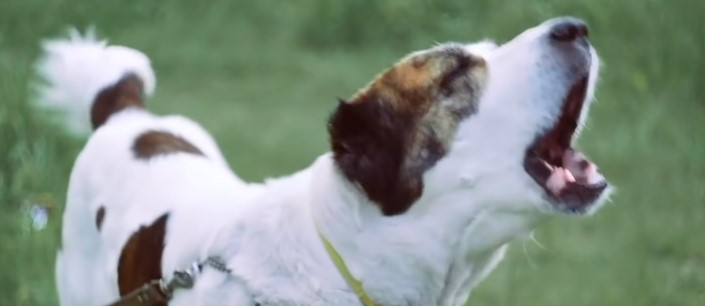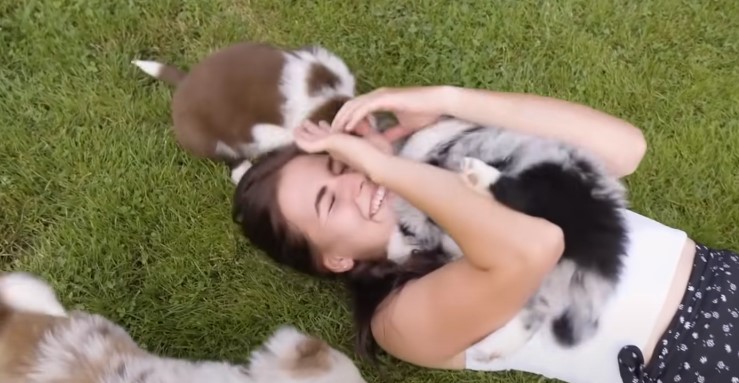The captivating allure of dogs’ howling is something that has long fascinated and intrigued humans. The haunting melody of their cries can send shivers down our spines while simultaneously nurturing a sense of connection to the natural world.
In this article, we will delve into the complex reasons behind why dogs howl at high-pitched sounds and explore the various factors that influence this behavior. By understanding the evolutionary background, communication elements, emotional triggers, and training techniques associated with howling, we can appreciate the beauty and significance of this canine vocalization.
Understanding Canine Vocalizations
Differentiating between barking and howling
One common misconception is the confusion between barking and howling. While barking is typically a response to immediate stimuli or a direct communication method, howling transcends mere signaling. It is a more profound vocalization, reflecting deeper emotions and serving as a form of expression.
Significance of vocalizations in dogs’ communication
Dogs utilize vocalizations as a means of communication, expressing a range of emotions such as happiness, fear, and excitement. Howling, specifically, plays a crucial role in conveying messages over long distances, establishing territory, and maintaining social cohesion within the pack.
The Fascinating Evolutionary Background of Howling

Tracing howling back to wolf ancestors
The roots of howling can be traced back to dogs’ ancestors, the wolves. It was through the evolution and domestication of wolves that dogs inherited this distinctive vocalization. Howling, in its essence, harks back to a time when wolves relied on long-range communication for survival and pack coordination.
The purpose of howling in the wild
In the wild, howling serves various purposes, including territory marking, rallying pack members together, and signaling danger or potential threats. By producing a harmonious chorus of sound, wolves synchronize their movements and establish a unified front against predators or other rival packs.
Unmasking the Communication Element in Howling
Insights into dogs’ social nature and howling’s role
Dogs are inherently social creatures, relying on social bonds to thrive. Howling acts as a form of communication that strengthens these bonds by unifying pack members, conveying emotional states, and coordinating group activities.
How howling enables pack cohesion and reinforcement
Through howling, dogs reinforce their pack’s social structure, solidify their sense of unity, and announce their presence to neighboring packs or individuals. It creates a sense of belonging and reassurance within the group, serving as a foundation for cooperation and mutual support.
The Acoustic World of Dogs
Dogs’ exceptional hearing capabilities
Dogs possess incredibly sensitive ears, far surpassing human auditory capabilities. Their ability to detect a vast range of sounds, including high-pitched frequencies, allows them to perceive the acoustic world in a unique manner.
Perception of high-pitched sounds in comparison to humans
While humans might find certain high-pitched sounds uncomfortable or even painful, dogs are more attuned to these frequencies. Their acute hearing enables them to catch even the faintest high-pitched sounds, which can trigger their instinctual response to howl.
The Emotional Triggers of Howling
Linking howling to emotional states
Howling is deeply intertwined with dogs’ emotional states. It can be triggered by various factors, including fear, anxiety, excitement, or even the desire for attention. Understanding the emotional underpinnings of howling can deepen our connection with our canine companions.
Understanding fear, anxiety, and excitement as factors
Fear, anxiety, and excitement all contribute to a dog’s propensity to howl. Whether it’s the fear of thunderstorms, the anxiety of being left alone, or the excitement of joining a lively chorus, these emotions can elicit a melodious howl from our four-legged friends.
Identifying the Variety of High-Pitched Sounds

Analyzing different types of high-pitched sounds
High-pitched sounds come in various forms, from the piercing screech of sirens to the melodic tunes of musical instruments. Each type of sound can elicit a unique response from dogs, affecting the pitch, duration, and intensity of their howls.
Common triggers for dogs’ howling
While there is a wide range of high-pitched sounds that can prompt dogs to howl, some common triggers include sirens, musical instruments, firework explosions, or the high-pitched voices of children. Dogs’ individual personalities and experiences also play a role in determining their response to specific sounds.
Can High-Pitched Sounds Be Harmful to Dogs?
Investigating the potential harmful effects
While dogs’ acute hearing allows them to appreciate high-pitched sounds, it also puts them at risk of potential harm. Continuous exposure to loud or intense high-pitched sounds can lead to stress, anxiety, and even physical discomfort, such as ear pain or damage.
Recognizing signs of distress in dogs
As responsible dog owners, it is crucial to recognize signs of distress in our furry companions. These signs may include changes in behavior, increased anxiety, restlessness, or excessive panting. Monitoring their reactions to high-pitched sounds can help us ensure their well-being.
The Impact of Breed and Genetic Predispositions
Breeds are known for increased howling tendencies
Certain dog breeds, such as the Alaskan Malamute, Siberian Husky, or Basset Hound, are known for their heightened howling tendencies. These breeds, with their genetic predispositions, exhibit an innate inclination to express themselves through howling.
Genetic factors influencing sensitivity to high-pitched sounds
Genetics plays a significant role in determining a dog’s sensitivity to high-pitched sounds. Some breeds have specific genetic traits that enhance their ability to perceive and respond to these sounds, while others may possess genetic variations that make them less reactive.
Environmental Factors and Howling
The influence of surroundings and context
Environmental factors, including the physical surroundings and social context, impact dogs’ howling behavior. Urban environments with constant background noise may have a different effect compared to serene rural settings, altering the frequency and intensity of howling.
Exploring the Role of Echo and Sound Reflection
The presence of natural or man-made echoes can shape the acoustics of a dog’s environment. These echoes and sound reflections may influence the way high-pitched sounds are perceived, potentially triggering a dog’s innate instinct to howl.
Training and Howling: Separating Myth from Reality

Examining popular beliefs about eliminating howling
There are numerous myths surrounding howling and its connection to training. Some believe that howling can be entirely eliminated through strict training regimens. However, it is essential to separate fact from fiction and understand that howling is a natural behavior deeply ingrained in dogs’ nature.
Effective training techniques
Rather than attempting to eliminate howling entirely, focusing on effective training techniques can help manage and control howling behaviors. Techniques such as positive reinforcement, distraction, and redirecting attention can provide a more harmonious coexistence between dogs and their human companions.
Howling for Attention: Strategies and Solutions
Seeking attention through howling
One common reason for howling is a dog’s desire for attention. By engaging in this behavior, dogs communicate their needs and attempt to engage their owners. Understanding the underlying motivation behind attention-seeking howling is crucial in finding effective strategies and solutions.
Teaching alternative behaviors
Redirecting a dog’s attention from howling to alternative, acceptable behaviors can be highly effective. Engaging in interactive play, providing mental stimulation, or teaching commands such as “speak” and “quiet” can help rechannel their need for attention and reduce excessive howling.
Howling and Separation Anxiety
Uncovering the link between howling and separation anxiety
For dogs suffering from separation anxiety, howling can become a coping mechanism. This intense anxiety in the absence of their owners triggers their need for reassurance and connection, resulting in prolonged and distressing howling episodes.
Coping mechanisms and professional advice
Managing separation anxiety requires a holistic approach that includes counterconditioning, desensitization, and, in severe cases, consulting a professional behaviorist. Addressing the underlying emotional distress and providing a supportive environment is crucial for both the dog’s well-being and the owner’s peace of mind.
Howling to Communicate and Bond with Humans
The role of humans in the dogs’ howling behavior
Dogs have an intrinsic desire to establish strong bonds with their human companions. Howling can serve as a means of communication and bonding, as dogs seek acknowledgment, validation, and reassurance from their humans.
Strengthening the human-canine bond through understanding
By understanding and accepting the significance of howling in dogs’ lives, we strengthen the bond with our furry friends. Recognizing their need for social connection and responding with patience, empathy, and love helps forge a deeper and more meaningful relationship.
Do Howling Techniques Vary Among Dog Breeds?
Exploring breed-specific howling characteristics
Different dog breeds exhibit unique howling characteristics based on their genetic heritage and historical roles. Some breeds have baying or howling tendencies deeply ingrained in their heritage, while others may have a more subdued vocalization style.
Unique vocalizations of distinct breeds
From the deep and mournful howls of bloodhounds to the melodic yodeling of Basenjis, each breed brings its distinctive vocalization style to the world of howling. Understanding these breed-specific variations can further enrich our appreciation for this fascinating behavior.
Urban Legends: Common Misconceptions about Dogs’ Howling
Dispelling popular myths surrounding howling
Despite dogs’ prominent role in our lives, there are still many misconceptions surrounding their howling behavior. Dispelling these urban legends, such as the belief that howling is always a sign of distress or unhappiness, ensures that accurate information prevails in the realm of responsible dog ownership.
Accurate information for responsible dog ownership
By debunking common myths and providing accurate information, we empower dog owners to make informed decisions and nurture healthy relationships with their pets. Responsible dog ownership entails understanding, empathy, and a willingness to learn about the intricacies of canine behavior.
Can Dogs Be Trained to Howl on Command?
Unleashing a dog’s howling talent
While training a dog to howl on command may seem like a fun and amusing skill, it is essential to approach this training with caution and consideration of individual dogs’ preferences and comfort levels. Not all dogs may enjoy performing this behavior on command.
Teaching dogs to howl on cue
For those interested in teaching their dogs to howl on cue, it can be done through positive reinforcement techniques. By associating a specific cue or command with the act of howling, dogs can learn to perform this behavior on request, strengthening the bond between dog and owner.
Curbing Excessive Howling: Tips and Tricks

Managing and reducing excessive howling
Excessive howling can become problematic for both the dog and their human companions. Addressing the underlying causes, whether it be boredom, anxiety, or medical issues, and employing techniques such as increased exercise, mental stimulation, and consistent training, can help manage and reduce excessive howling.
Creating a calmer environment for your dog
Creating a calm and secure environment is essential for curbing excessive howling. Factors such as structured routines, comfortable resting areas, and minimizing external stimuli can contribute to a serene environment that promotes a sense of well-being and reduces the need for excessive vocalization.
FAQs: Your Howling Questions Answered
Here are some frequently asked questions about dogs’ howling behavior, providing answers and insights into various aspects of this intriguing vocalization:
Why do some dogs howl more than others?
Dogs’ howling tendencies can vary based on breed, genetics, personality, and the specific environment they are in.
Is howling a sign of distress or loneliness?
While howling can indicate distress or loneliness in some cases, it is essential to consider the context, accompanying behaviors, and individual dog patterns before making assumptions.
Can howling be a learned behavior?
Yes, dogs can learn to howl from other dogs or by responding to certain stimuli. It can also be reinforced or discouraged through socialization and training experiences.
Is howling harmful to dogs’ vocal cords?
Howling, when performed within natural and healthy limits, is not harmful to dogs’ vocal cords. However, excessive or prolonged howling can potentially strain vocal cords, leading to temporary irritation.
Conclusion
Through this journey into the enigmatic realm of howling, we have discovered that dogs’ melodious howls represent more than just a vocalization. They encapsulate the essence of their ancestry, emotions, and their deep desire to communicate with us. By embracing the beauty of dogs’ howling, we forge a stronger bond with our furry companions and deepen our understanding of their unique place in our lives.








